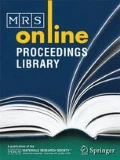Abstract
This work focuses on the fabrication of magnetic nanowires with specialized geometries, such as Y-junctions, tapers and multilayers, for magnetoresistive sensor arrays. First, anodic alumina nanopores were grown with diameters of 20–250nm and lengths up to tens of microns. These pores were removed from their Al substrates and the barrier oxide was removed. Co nanowires were initially grown inside the pores by electrochemical deposition. It was shown that the coercivity and remnant magnetization could be tripled in (100)-oriented Co by shrinking the pore diameter/interpore spacing from 150/300nm to 40/80nm. These properties were further enhanced by fabricating (002)-oriented Co using the proper pH and applying a magnetic field during growth. The ability to connect two or more nanostructures is critical to the long term success of nanoelectronics and circuits. Here, Y-junctions were grown by subsequent growth of 40nm then 20nm pores such that two smaller pores extended from the bottom of each larger pore. These pores were then filled with Co in order to produce Y-junctions in the magnetic nanowires. Next, multilayered nanowires were fabricated with alternating layers of Cu and Co. The Co layer thickness was varied in order to study the affect of shape anisotropy on the magnetic properties of Co layers inside arrays. Finally, several configurations for magnetoresistive magnetic field sensors were described.
Similar content being viewed by others
References
T. Ohgai, X. Hoffer, L. Gravier, J-E Wegrowe, J-Ph Ansermet, Nanotech. 14 (2003) 978.
H. Masuda, H. Yamada, M. Satoh, H. Asoh, M. Nakao, T. Tamamura, Appl. Phys. Lett. 71 (1997) 2770.
J. Choi, K. Nielsch, M. Reiche, R. Wehrspohn, U. Gosele, J. Vac. Sci. Tech. B21 (2003) 763.
L. Piraux, J George, J. Despres, C. Leroy, E. Ferian, R. Legras, K. Ounadjela, A. Fert, Appl. Phys. Lett. 65 (1994) 2484.
A. Blondel, J.P Meier, B. Doudin, J-Ph Ansermet, Appl. Phys. Lett. 65 (1994) 3019.
R. Cobian, MS Thesis, U Minnesota (2004).
T. Gao, G. Meng, J. Zhang, S. Sun, L. Zhang, Appl. Phys. A74 (2002) 403.
H Zeng, S Michalski, R D Kirby, D J Sellmyer, L Menon and S Bandyopadhyay, J. Phys. Cond. Matter 14 (2002) 715.
H. Masuda, K Fukuda, Science 268 (1995) 1466.
R. Hertel and J. Kirschner, Physica B 343 (2004) 206.
Author information
Authors and Affiliations
Rights and permissions
About this article
Cite this article
Stadler, B.J.H., Kim, N.h., Tan, L. et al. Nanowire Arrays with Specialized Geometries for Magnetoelectronics (Invited). MRS Online Proceedings Library 853, 7–18 (2004). https://doi.org/10.1557/PROC-853-I6.3
Published:
Issue Date:
DOI: https://doi.org/10.1557/PROC-853-I6.3




